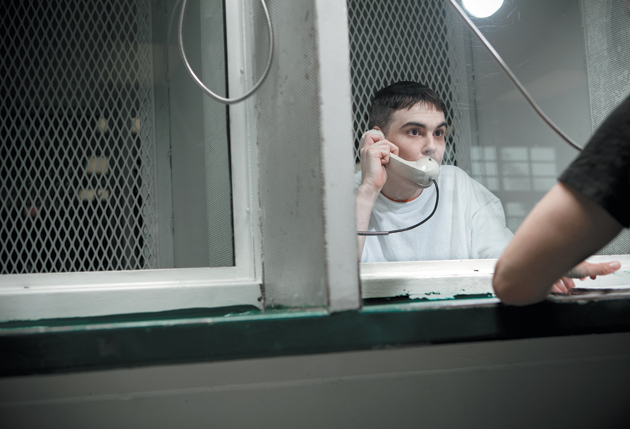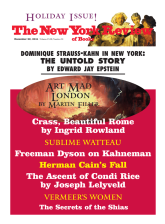A documentary film is often part stunt, part lab experiment, and the way a documentary filmmaker pursues his or her story will always involve a bit of amateur sleuthing, as well as improvisation. That such scriptless adventures have attracted a great director like Werner Herzog is curious but not alarming. Good documentary films can be made cheaply and we seem to be living in an abundantly golden—or at least copper (penny-wise)—era of them.
Herzog’s latest film, Into the Abyss, much like his 2005 documentary, Grizzly Man, uses the camera as a Geiger counter to locate some of the more toxic elements of the American cultural psyche (here the setting is small-town Texas’s well-traveled road to death row) as seen through the questing mind of a pseudo-squeamish European. Herzog works with a pretense of delicacy. Cellos play behind the scenic detritus of violence. Once again, in his soft, Teutonic, off-camera voice, Herzog insinuatingly, gently coaxes his interviewees—“How are you doing?” he often begins—while his camera registers a more ambiguous, startled fixation on people and places, a willingness to stare bluntly. Director and camera here are like good cop, bad cop.
While given the banal subtitle “A Tale of Death, a Tale of Life,” Into the Abyss doesn’t have its hands on an actual entire tale, as much as on the shiny pieces of many. The project seems to have initially aimed to tell the story of Mike Perry, a Texan inmate on death row for ten years, since the age of nineteen, who, when Herzog meets him, is scheduled for execution in eight days. Although the boyish, bucktoothed Perry eagerly speaks to Herzog and breaks everyone’s heart (almost all who are interviewed speak movingly and with great ostensible openness; how confessional reality television has prepped their personalities and polished their stories one can only guess), Perry’s family refused to appear in the film—a very large gap. (The Guardian has revealed that part of Perry’s eagerness derived from an expectation that Herzog would help him, and when his hopes were dashed he later raged against the director to the newspaper’s interviewer, who believed Perry to be bipolar.*)
Herzog then roams around the whole Texas scene of small-town dysfunction—screwdriver stabbings, joy rides in stolen cars, adult illiteracy—and capital punishment protocol. The actual crime—the shooting of three people in order to steal a red Camaro in a gated community called Highland Ranch—is so senseless and stupidly conceived that it is really just a worst-case portrait of teenage boy drunkenness, impulsivity, poverty-addled sociopathy, and a country so awash in weapons that it has arrived (perhaps once more) to a point in history where every high school student knows how and where to get a gun. This aspect is missing from Herzog’s social critique, which focuses on capital punishment and its inability to deter crime or restore its victims. The coveted red Camaro, a kind of CSI MacGuffin, now sits in a police crime lot with a hole in it from a tree that managed to grow through the floorboard.
The first person interviewed is not Perry but the death house chaplain who speaks to Perry of God (everyone in this picture, except Herzog, speaks faithfully of God) and who, as a gesture of kindness, a mere hour after speaking with Herzog, will hold Perry’s ankle during his execution on the gurney. “That’s what I do,” the chaplain says, “until death occurs.” He stands before a Huntsville cemetery of unnamed gravestones—the state graveyard for the executed who have gone unclaimed by their families. The field is an inland sea of stone crosses marked only with numbers.
The reverend is against the death penalty but in thinking of it before the camera he veers off into an anecdote about a golf trip and almost hitting a squirrel that “had stopped in the middle of the cart path,” and we can see how when pressed to illuminate its own contradictions the human mind can go on the fritz. This may really be Herzog’s theme. There is much strain and helplessness felt by the functionaries asked to dole out this ritualized punishment. (In a book titled Meals to Die For, whose cover photo is Karla Faye Tucker’s mug shot, a former Texas death house chef named Brian Price has written of the various last meal requests he received and attempted to honor, though this practice has now been discontinued by the Texas legislature. Like many employed in some part of an execution, Price felt his task was a humane one, part of what a civilized society should require; his offer to provide these meals at his own expense has recently been turned down by the state.)
Advertisement
Herzog’s interview of Fred Allan, the former captain of the Huntsville staff that straps the prisoners to the gurney, is a stirring example of someone who cracks under the pressure of paying work that involves killing up to two people a week. “It was getting tiresome,” he says in frightened remorse. After the execution of Karla Faye Tucker, with whom he had begun to feel a kind of bond, he has a breakdown and eventually quits his job, forswearing capital punishment as well as his pension. When he cracked, he says, all the hundreds he had helped execute came back to haunt him: “I saw them all in the holding pen.” Although he has nothing to do with Mike Perry’s story, he is an important part of Herzog’s film.
Perhaps the most moving soliloquy belongs to Delbert Burkett—the father of Perry’s partner in crime, Jason Burkett. Jason—who appears in the film looking simultaneously soldierly and apprehensive—was given life imprisonment, rather than the death penalty, thanks to his father’s testimony during the sentencing hearing, which so moved and mercifully softened the jury that he reiterates his eloquently self-blaming remarks for Herzog. Although his son Jason was living in squalor and chaos at the time of the murders, Delbert at that same age had won a football scholarship to the University of Texas at Austin only to drop out his senior year and, demoralized, eventually take up a life of meth cooking and theft. He and his son, both incarcerated—Delbert is also serving a life sentence for murder—recently spent a Thanksgiving dinner together, handcuffed, along with another incarcerated son, a low point in the father’s life, which he describes with a kind of naked shame. His memories of Jason as a sickly child with several neuroblastomas, a deadly cancer that required painful bone marrow treatment when he was “just a six-pound baby,” are heartrending and give a further glimpse into the injury and difficulties that can beset an already wobbling family and send it off the rails. Jason had eighteen surgeries before the age of five. “He had trash as a father,” says his dad. And a childhood of food stamps.
Herzog is interested in American violence reflected even in the names of Texas towns—Cut and Shoot is one—as well as the way that death and mayhem lying literally next door are moved on from, whereas superstition—rainbows and departed spirits—is not. Crater Lake, a spot where bodies were infamously disposed of, and was also used in the Perry-Burkett crime, is a stone’s throw from the gated community in Conroe that harbored the beloved Camaro. A sprawling new house near the crime scene is shown with a long winding driveway that paves over the place in the woods where one of the bodies was found. Herzog’s camera takes an unflinchingly quiet look. Dedicated to the victims and their families, the film gives perfect expression to the fear of a phone ringing: one of Herzog’s multiply bereaved interviewees has had the phone removed from her house. “I did not want another phone call telling me that someone in my family had died…. All it ever brought me was bad news.”
In seeking the bizarre, Herzog has one thing after another just fall into his lap. (That phoneless sister of one of the victims reveals that she is not actually his sister but his young aunt.) Perhaps nothing seems stranger than the marriage of inmate Jason Burkett to an Omaha woman who has taken an interest in his case and begins writing to him. She is petite and neatly coiffed, filmed against the backdrop of a cozily domestic living room. Their two-year courtship by letter is a perversely mythic one that echoes the Wild West’s sending east for schoolteachers and wives. After their marriage Melyssa Thompson-Burkett quickly becomes pregnant with Jason’s child—he wants fifty children, he says—and although she is at first reluctant to reveal the illegal details of this (semen smuggled out of the prison only days after they met), Herzog’s soft, Bavarian-accented voice, not completely unlike a Viennese analyst’s or even Hannibal Lecter talking to Clarice, entices it out of her.
She then, holding up her smartphone, shows us the ultrasound of the fetus, a ghostly image that Herzog’s camera does not turn away from. None of it offsets the motherlessness that both begins and pervades the film. “Scott Peterson gets a hundred letters a day on death row in California—that’s ridiculous,” says Thompson-Burkett, in an attempt to distinguish herself from other women who have fallen for handsome death row inmates. Like so many people in this riveting, often crushing, film, she does not on the surface appear to be crazy. One instead feels the truth of the adage that life is location, location, location. “You might want to get out of Texas as soon as possible” are Mike Perry’s parting words to Werner Herzog.
Advertisement
-
*
Joanna Walters, “Texas Death Row, Werner Herzog and the Man Who Maintained His Innocence,” The Guardian, November 4, 2011. ↩




